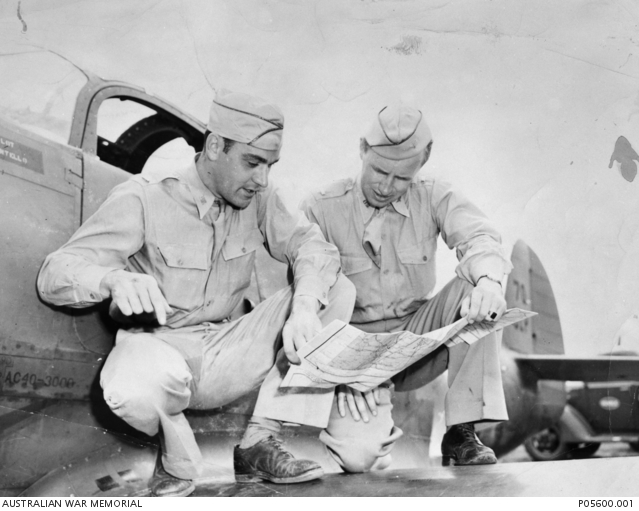| Place | Oceania: Australia, New South Wales, Sydney, Bankstown |
|---|---|
| Accession Number | P05600.001 |
| Collection type | Photograph |
| Object type | Negative |
| Maker |
Unknown |
| Place made | Australia: New South Wales, Sydney, Bankstown |
| Date made | c 1942 |
| Conflict |
Second World War, 1939-1945 |
| Copyright |
Item copyright: Copyright expired - public domain
|
Portrait of 1st Lieutenant (1st Lt) George Leo Cantello (left) Commanding Officer of the 41st ...

Portrait of 1st Lieutenant (1st Lt) George Leo Cantello (left) Commanding Officer of the 41st Pursuit Squadron, 35th Pursuit Group, United States Army Air Force (USAAF) and another unidentified USAAF officer both looking at a map whilst on the wing of Lt Cantello's P-39 Bell Airacobra. For a time, this USAAF squadron (equipped with P-39 Airacobras) was based at Bankstown airport, near Sydney, NSW. One week after the Japanese midget submarine raid on shipping in Sydney Harbour, the Imperial Japanese Navy (IJN) still had a number of submarines submerged off the east coast of Australia, three of them vainly waiting to recover their midgets and two others which had been tasked with shelling the Australian mainland. Just after midnight, on the morning of 8 June 1942, a submarine of the IJN (I-24), surfaced approximately ten kilometres offshore from Sydney's Maroubra Beach and rapidly fired ten rounds of 140 mm shells from the main deck gun. Six of the shells failed to explode and the remaining four caused minor damage to houses in the Eastern Suburbs and slightly injured one person. The submarine immediately crash dived, leaving wailing air raid sirens and searchlights sweeping the Sydney sky. In response to the shelling, a phone call was received by the 41st Pursuit Squadron at Bankstown airport and just before 1.00 am a solitary P-39 Airacobra piloted by 1st Lieutenant Cantello, took off in the hope of striking back at the Japanese. Not long after take off, over the small farming community of Hammondville, the P-39 stalled and crashed, killing the 27 year old pilot. The cause of the crash is not known, but it was suggested that in his haste to get airborne the engine had not been properly warmed. The following day the twisted remains of the aircraft was recovered and the body of George Cantello was sent for burial at a US military cemetery in Sydney. Post-war his remains were taken to the 'Punchbowl' War Cemetery in Hawaii. In 1988, at Hammondville, a memorial park with a monument was opened, dedicated to the memory of Lt George Cantello by the United States and Australian Governments.
